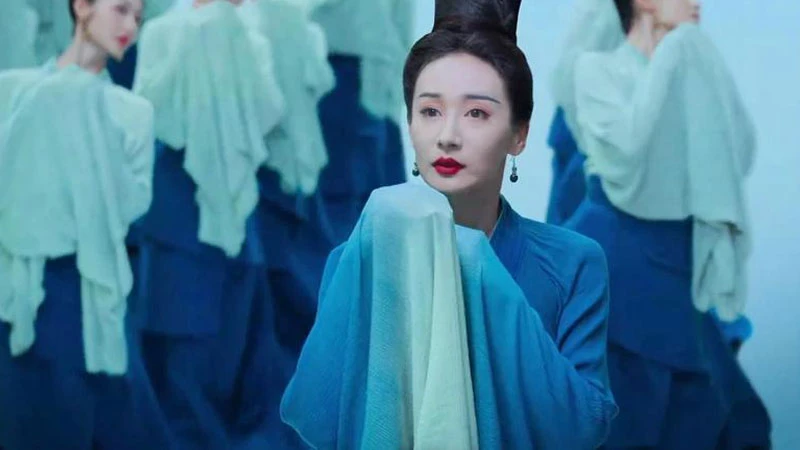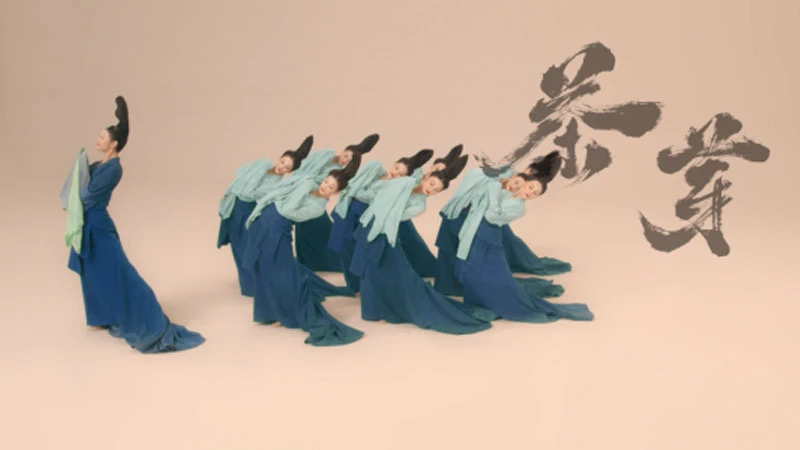Costume Design Breathes Life into Song Dynasty Artistry
In the realm where celluloid dreams and historical artistry converge, a new cinematic masterpiece is poised to captivate audiences and redefine the landscape of Chinese cinema. "Only This Green," (只此青绿) a film that draws its inspiration from one of China's most revered paintings, "A Thousand Li of Rivers and Mountains," (千里江山图) is set to unveil a visual feast that transcends time and medium.
At the heart of this cinematic odyssey lies an unparalleled attention to detail in costume design and makeup artistry. The recently released stills offer a tantalizing glimpse into a world where every thread, every hue, and every ornament tells a story. The film's costume designers have embarked on a sartorial pilgrimage, meticulously crafting garments that not only reflect the aesthetic sensibilities of the Song Dynasty but also resonate with contemporary audiences.
The young prodigy, Ximeng, is adorned in a gossamer-like black silk veil and attire crafted from authentic silk, embodying the ethereal genius of a painter touched by divine inspiration. In stark contrast, the ensemble of artisans known as the "green craftsmen" don garments that echo the very palette of "A Thousand Li of Rivers and Mountains." Their costumes, with their layered sleeves and cascading hems, mirror the undulating landscapes they strive to capture on silk.
Perhaps most striking is the costume of the stone grinder, whose attire bears the texture of weathered rock, a tactile homage to the arduous journey of sourcing pigments from nature's palette. The ink maker, resplendent in deep carmine, stands as a testament to the countless hours spent pounding pine soot into the lifeblood of Chinese painting.
Makeup artists have resurrected the "three whites" technique of Song Dynasty cosmetics, bestowing upon the silk weaver a visage of timeless elegance. The seal carver's sleeves, intricately pleated to echo the very characters they engrave, blur the line between artist and art. Female officials of the Hanlin Academy sport the "pearl makeup" style, a subtle nod to the refined tastes of the era's literati.
Only This Green Captivates Pre-Release Audiences
This meticulous approach to visual storytelling extends beyond mere aesthetics. Each costume, each brushstroke of makeup, serves as a portal through which the audience can step into the shoes of these historical figures. It's a sensory bridge spanning a millennium, allowing viewers to not just see but feel the weight of history and the lightness of artistic inspiration.
As "Only This Green" prepares for its national release during the upcoming Golden Week holiday, the film has already begun to weave itself into the cultural fabric of modern China. Limited pre-screenings over the past two weeks have been met with overwhelming enthusiasm, with theaters filled to capacity and audiences emerging with glowing reviews.
The film's resonance with viewers spans generations and backgrounds. Parents speak of the joy of sharing a "visual and spiritual feast" with their children, while others describe the experience as a transformative journey into the heart of Eastern aesthetics. The working class has found particular kinship with the film, with many claiming that a single frame is enough to "wash away the weariness of labor."
Responding to the clamor for more opportunities to experience the film before its official release, the producers have announced an expanded pre-screening schedule. During the Mid-Autumn Festival from September 15th to 17th, limited showings will be held in 30 cities across the nation. This strategic move not only builds anticipation for the film but also aligns its themes of artistic creation and cultural heritage with a holiday traditionally associated with family reunion and appreciation of beauty.
"Only This Green" is more than a retelling of how a masterpiece came to be; it is a celebration of the collective spirit that drives artistic innovation. By focusing on the 18-year-old Ximeng and the craftsmen who worked alongside him, the film illuminates the often-overlooked collaborative nature of great art. It reminds us that behind every stroke of genius lies countless hands mixing pigments, weaving silk, and grinding stone.
As the film industry in China continues to evolve, "Only This Green" stands as a testament to the power of cultural confidence. It demonstrates that there is a hungry audience for stories that delve deep into the wellspring of Chinese civilization while employing cutting-edge filmmaking techniques. The film's success in pre-screenings suggests a shifting paradigm in audience preferences, one that values substance and cultural resonance alongside spectacle.
In a world where the pace of change can be dizzying, "Only This Green" offers a moment of reflection, a chance to connect with the enduring spirit of Chinese aesthetics. As it unfurls across screens this Golden Week, it invites viewers to step into the painting, to lose themselves in the mist-shrouded mountains and serpentine rivers of both landscape and imagination.
The film stands as a bridge—between past and present, between artist and audience, between individual genius and collective craftsmanship. In doing so, it doesn't just tell the story of a painting; it becomes a new brushstroke in the ongoing masterpiece of Chinese cultural expression. As viewers emerge from theaters, they carry with them not just memories of a film, but a renewed appreciation for the living heritage that continues to color the canvas of Chinese identity.



